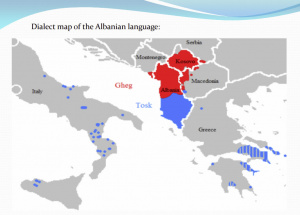Language/Tosk-albanian/Grammar/Adjectives-and-Nouns-Agreement
Introduction
Welcome to this lesson on Tosk Albanian adjectives and their agreement with nouns. In this tutorial, you will learn how to use adjectives with nouns and how to make sure they agree in gender, number, and case.
Adjectives are used to describe nouns and are essential in any language to make your speech or writing more colorful and expressive. Adjectives agree with the gender of the noun they are describing.
For example, if you want to describe a car in Tosk Albanian, you would use the feminine adjective "e bukur" if the car is feminine or the masculine adjective "i bukur" if it's masculine.
Let's start by understanding how to make adjectives agree with the gender of nouns in Tosk Albanian.
Gender Agreement
In Tosk Albanian, as in many other languages, there are two genders: masculine and feminine. Masculine nouns generally end in consonants, while feminine ones end in -a or -e.
To make a Tosk Albanian adjective agree with the gender of the noun it's describing, you need to adjust the ending of the adjective according to the gender of the noun.
For example, if the noun is feminine, then the adjective must also end in -e; if it's masculine, then the ending must be -i.
Let's take a look at some examples:
| Tosk Albanian | Pronunciation | English |
|---|---|---|
| makinë e mirë | mah-ki-nuh eh meer-uh | good car (feminine) |
| libër i mirë | lih-buhr ee meer-uh | good book (masculine) |
| rrugë e vogël | roo-guh eh vo-guhl | small road (feminine) |
| zog i vogël | zoh-guh ee vo-guhl | small bird (masculine) |
As you can see, the adjective agrees with the gender of the noun it's describing.
Number Agreement
In addition to gender, adjectives in Tosk Albanian must also agree in number with the noun. The two numbers are singular and plural.
To make an adjective agree with the number of the noun it's describing, you need to add an -ë ending to the adjective for the plural.
Here's an example of the same noun and adjective in both singular and plural:
| Tosk Albanian | Pronunciation | English |
|---|---|---|
| makinë e mirë | mah-ki-nuh eh meer-uh | good car (singular) |
| makina të mira | mah-kee-nuh tuh meer-uh | good cars (plural) |
Case Agreement
In Tosk Albanian, just like in many other languages, there are different cases for nouns, and adjectives need to agree with the case of the noun they are describing.
For example, if the noun is in the accusative case, then the adjective must also agree with the accusative case.
Here's an example:
| Tosk Albanian | Pronunciation | English |
|---|---|---|
| unë kam makinë të mirë | oo-nuh kahm mah-kee-nuh tuh meer-uh | I have a good car (nominative) |
| unë shoh një makinë të mirë | oo-nuh shoh nyuh mah-kee-nuh tuh meer-uh | I see a good car (accusative) |
As you can see, the adjective "mirë" changes to "të mirë" to agree with the accusative case of the noun "makinë."
Conclusion
In this lesson, you learned how to agree adjectives with nouns in Tosk Albanian. You learned that adjectives must agree with the gender, number, and case of the noun they are describing.
It's important to remember that Tosk Albanian adjectives are flexible, and you can move them around to emphasize different meanings or to create different sentence structures.
Now, it's time to practice using adjectives with nouns! Remember to take note of the gender, number, and case of the noun you're describing, and adjust the ending of the adjective accordingly.
Good luck, and keep practicing!

